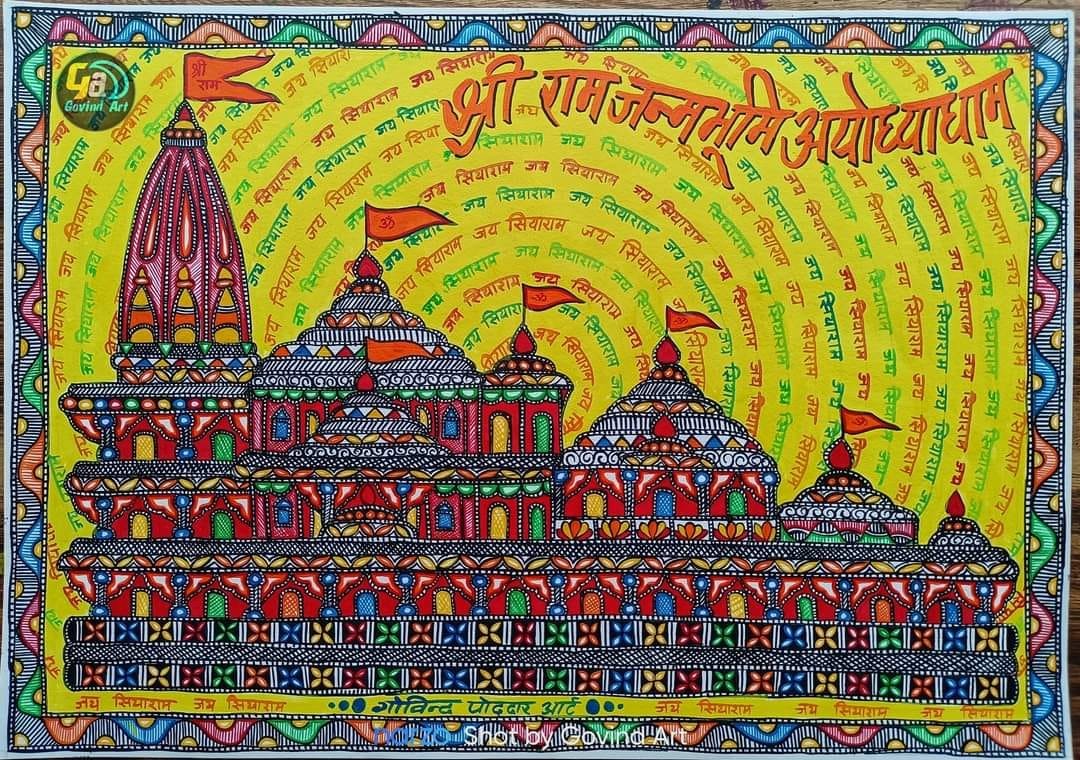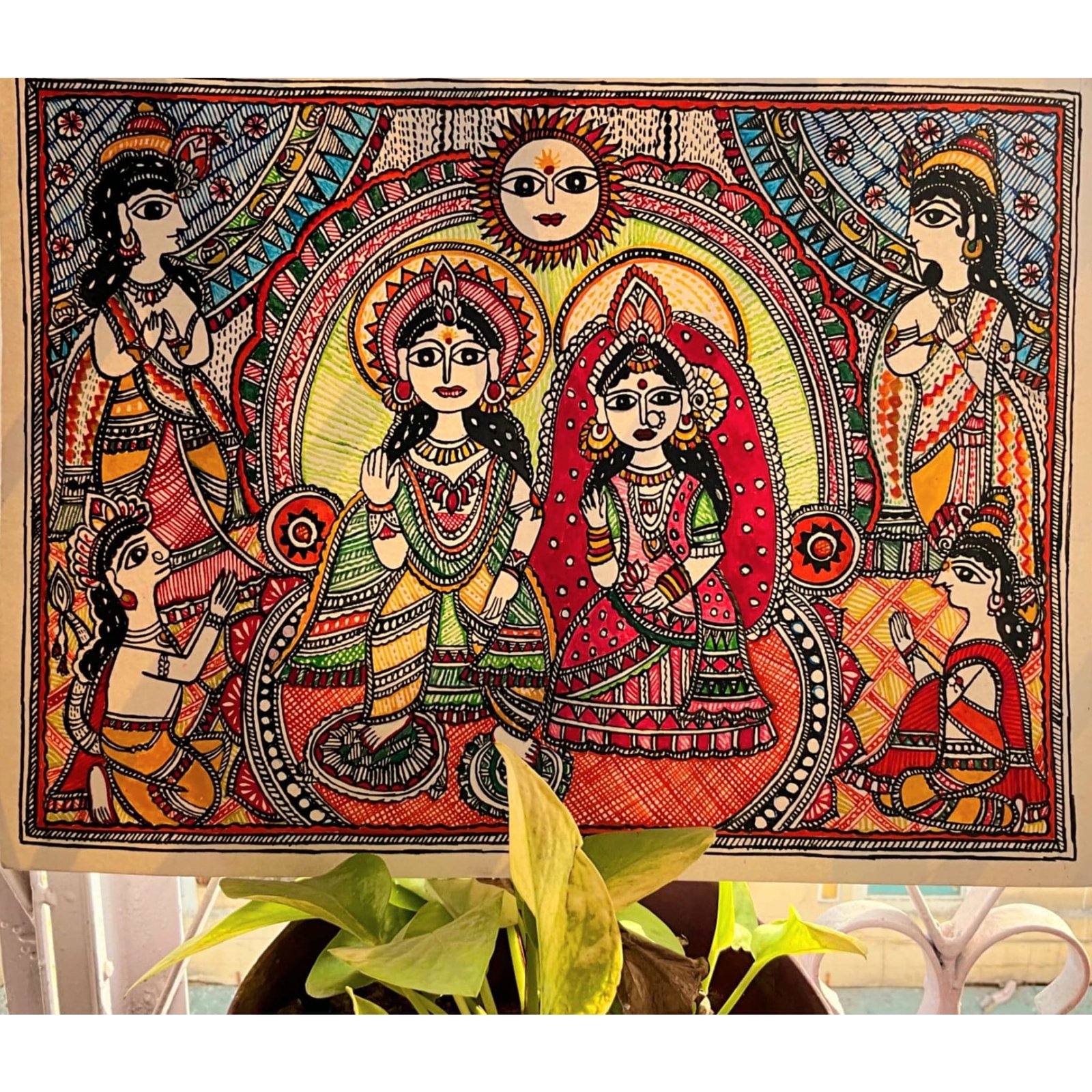Table of Contents
Top 10 Mithila Painting January 2024 | Top 10 Madhubani Painting 2024
Madhubani Painting or Mithila Painting has its origins in Mithila region of Bihar. Often characterised by the complex geometrical patterns, these painting are known for representing ritual content for particular occasions, including festival, religious rituals etc.The colors used in Madhubani painting are usually derived from plants and other natural resources. These colors are often bright and pigments like lampblack and ochre are used to create black and brown respectively. Objects like twigs, matchsticks and even fingers are used to create the paintings.
Madhubani paintings originated in the Mithila region of Bihar border of Indian & Nepal. Heritage of Madhubani art goes back a minimum of 2,500 years and its celebrated figures embody Buddha and Mahavira. it’s additionally the birthplace of mythical being ‘Sita’, the central character in Ramayana. Hence, her life stories are oftentimes represented within the native art.
Let’s explore the top 10 Mithila paintings january 2024 that captivate art enthusiasts worldwide.
1.Mithila Painting By Kundan Kumar Roy

2.Mithila Painting By Puja Jha

3.Mithila Painting By Govind Poddar

4.Mithila Painting By Dr. Chhaya Jha

5.Mithila Painting By Poonam Mishra in Guidance of Kanchan Jha

6.Mithila Painting By Kirti Bhawe

7.Mithila Painting By Raunak Kumar

8.Mithila Painting By Anannya Sengupta

9.Mithila Painting By Sneha Surbhi

10.Mithila Painting By Swati Kumari

आब हर महीना टॉप 10 मिथिला पेंटिंग, अपन मिथिला द्वारा Promote कयल जायत । जनवरी टॉप 10 लिस्ट लेल अपन पेंटिंग जमां करू।
जय मिथिला 🙏
| Top 5 Madhubani Painting | Click Here |
| Top 10 Tila Sankranti Maithili Geet | Click Here |
| IVR in Maithili | Benefits of IVR in Maithili | Click Here |
Importance of Mithila Painting or Madhubani Painting
Mithila painting, also known as Madhubani art, stands as a vibrant testament to the rich cultural heritage of the Mithila region in Bihar, India. With its intricate patterns, vivid colors, and deep-rooted cultural significance, Mithila painting has transcended geographical boundaries to become a symbol of artistic expression and storytelling. This traditional folk art form carries immense importance, not only for its aesthetic appeal but also for its role in preserving and promoting the cultural identity of the Mithila community.
Preserving Cultural Heritage:
Ancient Roots and Traditions: Mithila painting has deep roots in ancient traditions, dating back to several centuries. Passed down through generations, this art form serves as a visual chronicle of the region’s cultural evolution, capturing stories, rituals, and beliefs that have been cherished for centuries.
Cultural Narratives and Mythological Themes: The paintings often depict mythological themes and religious narratives, providing a visual representation of epics such as the Ramayana and Mahabharata. Through these artworks, Mithila artists contribute to the preservation and propagation of their cultural stories and beliefs.
Promoting Artistic Expression:
Community Identity and Artistic Individuality: Mithila painting plays a crucial role in defining the identity of the Mithila community. Artists express their individuality through unique patterns and styles, contributing to the diversity within the broader spectrum of Mithila art. Each stroke on the canvas reflects the artist’s connection to their cultural roots.
Empowering Women Through Art: Historically, Mithila painting has been a significant source of empowerment for women in the region. Traditionally, women were the primary practitioners of this art form, and through their paintings, they found a voice to communicate their experiences, emotions, and perspectives.
Preservation of Traditional Techniques:
Skill Transfer Across Generations: Mithila painting is often a family tradition, with techniques and skills passed down from one generation to the next. This intergenerational transfer ensures the preservation of traditional methods, maintaining the authenticity of the art form over time.
Natural and Eco-friendly Practices: The use of natural dyes and pigments derived from plants and minerals is a characteristic feature of Mithila painting. This eco-friendly approach not only aligns with traditional practices but also promotes sustainable art, minimizing the environmental impact of artistic expression.
Global Recognition and Economic Impact:
International Appreciation: Mithila painting has gained international acclaim, with art enthusiasts and collectors recognizing its uniqueness and cultural significance. The global appreciation has not only elevated the status of Mithila artists but has also opened avenues for cross-cultural exchanges.
Economic Empowerment: As Mithila painting gains prominence in the global art market, it contributes to the economic empowerment of local artists and communities. This economic sustainability is vital for the continuation of this traditional art form in contemporary times.
FAQ : Top 10 Madhubani Painting January 2024
What is Mithila Painting?
- Mithila painting, also known as Madhubani art, is a traditional folk art form that originated in the Mithila region of Bihar, India. It is characterized by vibrant colors, intricate patterns, and often depicts themes from Hindu mythology.
What are the Top 10 Madhubani Paintings?
- The top 10 Mithila paintings include iconic themes like “Sita Haran” (The Abduction of Sita), Krishna Leela (The Divine Play of Krishna), Bharni Style Paintings, Kachni Style Paintings, Godhuli Bela (Twilight Hour), Tantrik Art, Shakti Peeth Paintings, Dharni Style Paintings, Fish Motif Paintings, and Nature-inspired Paintings.
What is the significance of “Sita Haran” in Mithila Painting?
- “Sita Haran” depicts the moment when the demon king Ravana abducts Sita, a popular theme from the Ramayana. It showcases the artist’s skill in bringing to life the epic tale through intricate detailing and vivid colors.
What distinguishes Bharni Style Paintings in Mithila Art?
- Bharni Style Paintings are known for their detailed and elaborate patterns, featuring densely filled colors. These paintings often portray mythological themes, intricate borders, and meticulous detailing, showcasing the artist’s mastery.
How are Kachni Style Paintings characterized in Mithila Art?
- Kachni Style Paintings are characterized by fine lines and delicate patterns. Artists use black outlines to create visually arresting compositions, depicting themes ranging from religious motifs to daily life.
What is the theme of “Godhuli Bela” in Mithila Paintings?
- “Godhuli Bela” captures the serene beauty of the evening twilight. These paintings use warm hues and soft strokes to evoke a sense of peace, making them a popular choice for those seeking a soothing visual experience.
What is Tantrik Art in Mithila Painting?
- Tantrik Art in Mithila paintings involves ritualistic and symbolic depictions. Artists use geometric patterns, symbols, and esoteric motifs to create compositions that hold deeper spiritual meanings, reflecting the close connection between Mithila culture and ancient tantric practices.
How do Shakti Peeth Paintings in Mithila Art honor Goddess Shakti?
- Shakti Peeth Paintings pay homage to various sacred sites associated with Goddess Shakti. These vibrant artworks often depict the goddess in her various forms, surrounded by intricate patterns and symbols, holding religious significance for devotees.
What distinguishes Dharni Style Paintings in Mithila Art?
- Dharni Style Paintings showcase a fusion of tradition and innovation. Artists experiment with new themes and incorporate modern elements while staying true to the essence of Mithila art, creating a dynamic and appealing blend.
Why are Fish Motif Paintings common in Mithila Art?
- Fish motif paintings are common in Mithila art due to their auspicious symbolism representing fertility and abundance. Artists integrate fish motifs into wedding and fertility-themed artworks, adding a unique charm to these paintings.



